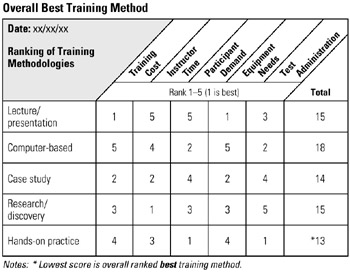Tool 159: Ranking Matrix
| AKA | Criteria Ranking |
| Classification | Evaluating/Selecting (ES) |
Tool description
The ranking matrix tool is applied when rank ordering several options on the basis of a set of team-established criteria or guidelines. Comparing options against each other, ranks are assigned to each option to determine the "best" or "worst" standing of all listed and ranked options on the matrix.
Typical application
-
To determine a preferred or perceived best problem solution or process-improvement opportunity.
-
To assist a team in reaching consensus.
-
To cross-validate any other assessment technique, such as a rating matrix.
-
To simply rank order all available options on the basis of comparing all options against established criteria.
Problem-solving phase
| → | Select and define problem or opportunity |
| Identify and analyze causes or potential change | |
| → | Develop and plan possible solutions or change |
| → | Implement and evaluate solution or change |
| → | Measure and report solution or change results |
| → | Recognize and reward team efforts |
Typically used by
| 5 | Research/statistics |
| Creativity/innovation | |
| Engineering | |
| 4 | Project management |
| Manufacturing | |
| 3 | Marketing/sales |
| Administration/documentation | |
| Servicing/support | |
| 2 | Customer/quality metrics |
| 1 | Change management |
before
-
Data Collection Strategy
-
Brainstorming
-
Brainwriting Pool
-
Affinity Diagram
-
Focus Group
after
-
Run-It-By
-
Different Point of View
-
Problem Specification
-
Action Plan
-
Point-Scoring Evaluation
Notes and key points
-
Assign rank 1–5 in accordance with how well each training method meets the criteria. Rank 1 (low) is the preferred method; lowest total score is overall best training method.
Step-by-step procedure
-
STEP 1 The team determines the criteria for ranking the options. See example Overall Best Training Method.
-
STEP 2 A ranking matrix is constructed and all criteria is listed across the top with a respective scale and translation, as seen in the example.
-
STEP 3 All options to be ranked are listed in the vertical matrix column.
-
STEP 4 Each option is ranked in comparison to all other options.
-
STEP 5 All ranks are added across to arrive at a total value. The lowest total ranks as the best option.
Example of tool application

EAN: 2147483647
Pages: 326